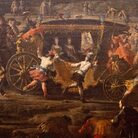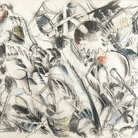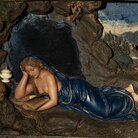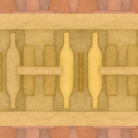Navjot Altaf. Samakaalik: Earth Democracy and Women’s Liberation (Democrazia della Terra e Femminismo)

© Navjot Altaf | Navjot Altaf, Soul Breath Wind (2014-18). Proiezione doppio canale con suono, 60', in loop
Dal 2 November 2019 al 16 February 2020
Torino
Luogo: PAV - Parco Arte Vivente
Indirizzo: via Giordano Bruno 31
Curatori: Marco Scotini
Telefono per informazioni: +39 011 3182235
E-Mail info: info@parcoartevivente.it
Sito ufficiale: http://www.parcoartevivente.it
Sabato 2 novembre 2019 alle ore 19, in occasione di Artissima, il PAV Parco Arte Vivente inaugura Samakaalik: Earth Democracy and Women’s Liberation (Democrazia della Terra e Femminismo), la prima personale italiana di una delle artiste indiane più radicali, Navjot Altaf (Meerut, 1949). La mostra, a cura di Marco Scotini, rappresenta un nuovo capitolo nell’indagine del rapporto tra pratiche artistiche e pensiero ecologista nel continente asiatico. Con Navjot Altaf, il PAV sceglie di presentare l’intersecarsi simultaneo (samakaalik in hindi) delle lotte per la tutela ambientale al movimento femminista, una forma intersezionale di ecofemminismo che Bina Agarwal ha definito “feminist environmentalism”. I lavori di Altaf indagano lo sfruttamento minerario e dell'agricoltura intensiva, l'industria pesante, la consunzione delle foreste, riflettendo sulla sovranità culturale delle popolazioni indigene.
Samakaalik si pone il complesso obiettivo di ricostruire il percorso dell'artista sin dalla militanza con il collettivo Marxista PROYOM: la mostra si apre proprio con alcuni manifesti dell'epoca, nei quali troviamo i presupposti sviluppati nelle decadi successive. Accanto alle pratiche collaborative con artisti indigeni e membri della comunità di Bastar, la ricerca di Navjot si è focalizzata sulle aree minerarie del sud del distretto e della parte centro-settentrionale del paese. L'installazione video a doppio canale Soul Breath Wind indaga la lenta violenza delle attività di estrazione: una narrazione condotta grazie alla voce delle comunità locali in lotta. A fianco del video, le piccole sculture Patterns which Connect incarnano l'importanza della coesistenza tra specie sotto la minaccia ecologica, un aspetto già presente nel 1972, nel ciclo di disegni pedagogici Insects Logos. Nel ciclo How Perfect Perfection Can Be, la dimensione architettonica funziona come campo d'indagine degli aspetti più oscuri delle ideologie del progresso. Il video Trail of Impunity ci racconta l'insurrezione violenta delle comunità di Gujarat del 2002, attraverso innumerevoli conversazioni sulla nozione di dignità umana, sulla critica alla violenza e sulla possibilità di giustizia a fronte di un sistema politico corrotto.
Il rapporto tra oppressione della donna e sistema capitalista è stato ampiamente indagato da autrici come Silvia Federici, Mariarosa Dalla Costa, Maria Mies, tra le altre, che sottolineano il ruolo chiave dei processi produttivi e riproduttivi all’interno della valorizzazione capitalistica.
Nella specificità del contesto post-coloniale indiano, le diverse forme del pensiero ecofemminista conoscono una particolare rilevanza: dalle note battaglie di Vandana Shiva, orientata ad una lettura essenzialista del rapporto tra donna e natura, a quelle dell'economista Bina Agarwal, che insiste, invece, sulla centralità dei rapporti sociali. Nella ricerca di Agarwal, le donne lavoratrici delle aree rurali dell'India incarnano un potente agente di resistenza alla “favola dello sviluppo” imposta dal capitalismo occidentale. In questa prospettiva s'inserisce anche il pensiero della filosofa della scienza Meera Nanda, che indaga la relazione tra oppressione femminile e sistema delle caste.
Attraverso i suoi lavori - sottolinea la più importante storica dell'arte, critica e curatrice indiana Geeta Kapur - Navjot conduce una costante decostruzione di quelle convenzioni identitarie (l'essere donna, l'essere lavoratore, l'essere contadino) fondate su un linguaggio culturalmente determinato, su un sistema fondato su divisioni sociali strutturalmente complici al patriarcato e al capitalismo. Le forme di identificazione in divenire, meticce e in definitiva simultanee sulle quali lavora Altaf, si costruiscono invece con la consapevolezza che ogni sistema identitario è intrinsecamente esclusivo, tutte le identità categoriche, tutte le istanze ideologiche sono interdipendenti e che la comprensione della posizione del soggetto è sempre contingente.
Il suo lavoro è stato esposto in importanti musei e istituzioni quali NGMA Mumbai (2019), KNMA Delhi (2014), MMCA Korea (2013), Frost Art Museum USA (2009), House of World Culture (2003), Tate Modern London (2001) e biennali internazionali tra cui la 14° Curitiba Biennial (2019), la Second Yinchuan Biennale (2018), la Biennale di Shanghai (2017), la Kochi Muziris Biennale (2014), la Biennale di Sydney (2006) e la Biennale di Havana (2003).
La mostra è realizzata con il sostegno della Compagnia di San Paolo, della Fondazione CRT, della Regione Piemonte e della Città di Torino.
All’interno delle iniziative previste per l’approfondimento della mostra Samakaalik: Earth Democracy and Women’s Liberation le Attività Educative e Formative del PAV propongono Giardino Segreto, attività che unisce il contatto diretto con la natura e la dimensione artistico-espressiva emergenti dalle opere di Navjot Altaf e dei numerosi autori presenti nel corso del tempo all’interno del programma espositivo del PAV, artisti provenienti da culture e ambienti dell’Eurasia, dell’Africa e delle Americhe. In particolare, attraverso un’esperienza di immersione nelle opere presenti nelle mostre temporanee, si possono osservare tutti gli aspetti legati alla trasformazione e alla ciclicità della natura rielaborata in chiave estetico-affettiva. In laboratorio, mediante forme floreali provenienti dall’iconografica botanica, viene creato un giardino collettivo, luogo immaginifico in cui seminare i propri desideri.
SCARICA IL COMUNICATO IN PDF
COMMENTI

-
 Dal 20 December 2025 al 20 April 2026
Caserta | Reggia di Caserta
Dal 20 December 2025 al 20 April 2026
Caserta | Reggia di Caserta
Regine: trame di cultura e diplomazia tra Napoli e l’Europa
-
 Dal 19 December 2025 al 23 March 2026
Torino | Palazzo Madama - Museo Civico d’Arte Antica
Dal 19 December 2025 al 23 March 2026
Torino | Palazzo Madama - Museo Civico d’Arte Antica
Il castello ritrovato. Palazzo Madama dall’età romana al medioevo
-
 Dal 17 December 2025 al 19 January 2026
Roma | Palazzo della Cancelleria
Dal 17 December 2025 al 19 January 2026
Roma | Palazzo della Cancelleria
De Humana Mensura di Linda Karshan
-
 Dal 18 December 2025 al 12 April 2026
Firenze | Gallerie degli Uffizi
Dal 18 December 2025 al 12 April 2026
Firenze | Gallerie degli Uffizi
Cera una volta. Sculture dalle collezioni medicee
-
 Dal 11 December 2025 al 9 April 2026
Firenze | Museo Archeologico Nazionale di Firenze
Dal 11 December 2025 al 9 April 2026
Firenze | Museo Archeologico Nazionale di Firenze
Icone di Potere e Bellezza
-
 Dal 11 December 2025 al 11 January 2026
Roma | Palazzo Esposizioni Roma
Dal 11 December 2025 al 11 January 2026
Roma | Palazzo Esposizioni Roma
Giorgio Morandi nella Collezione Eni. Un viaggio attraverso la storia culturale del cane a sei zampe e l’eredità di Enrico Mattei


